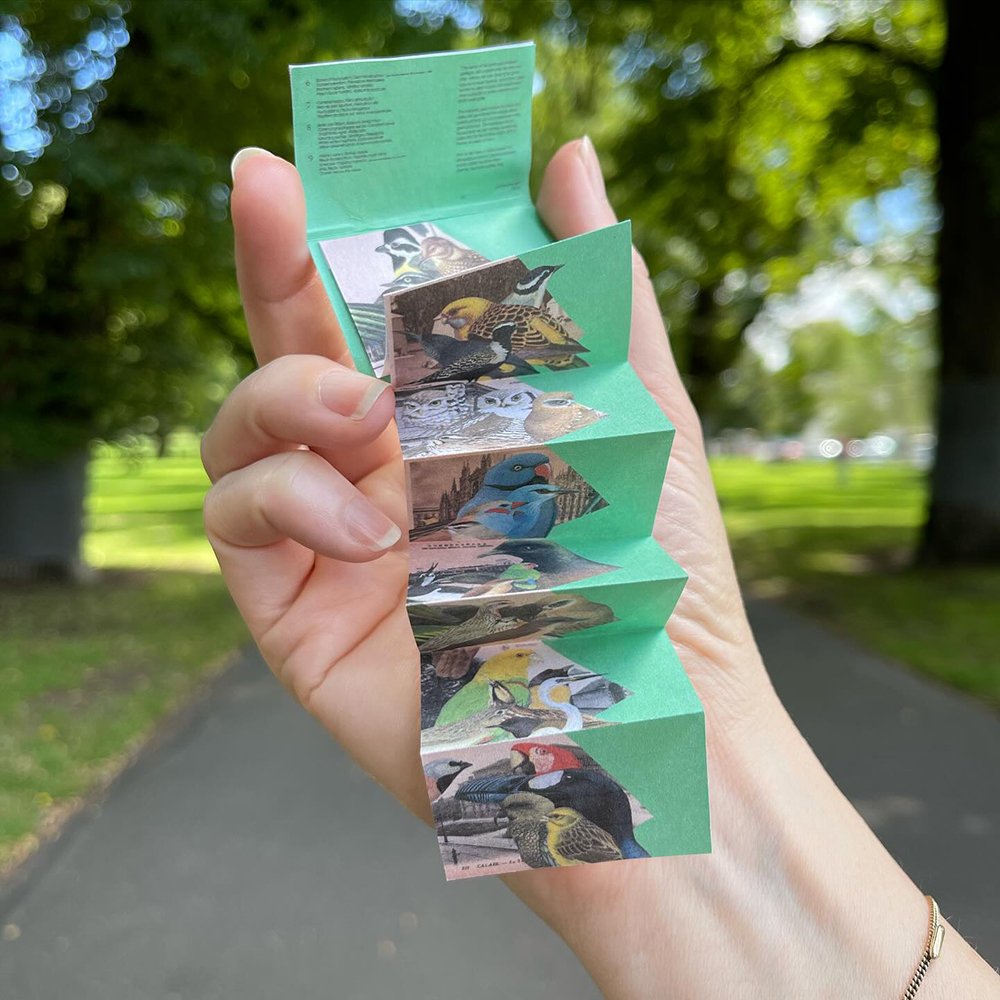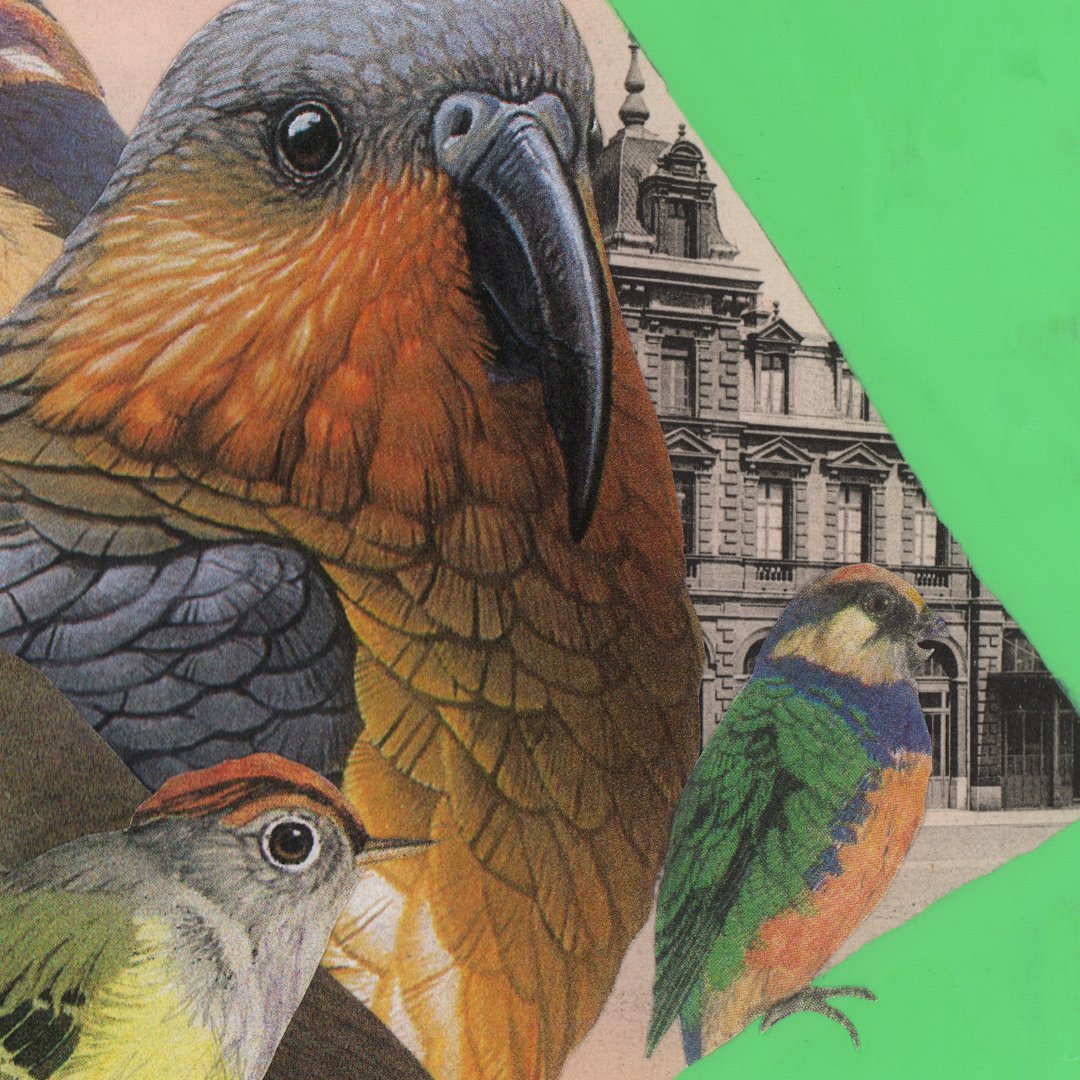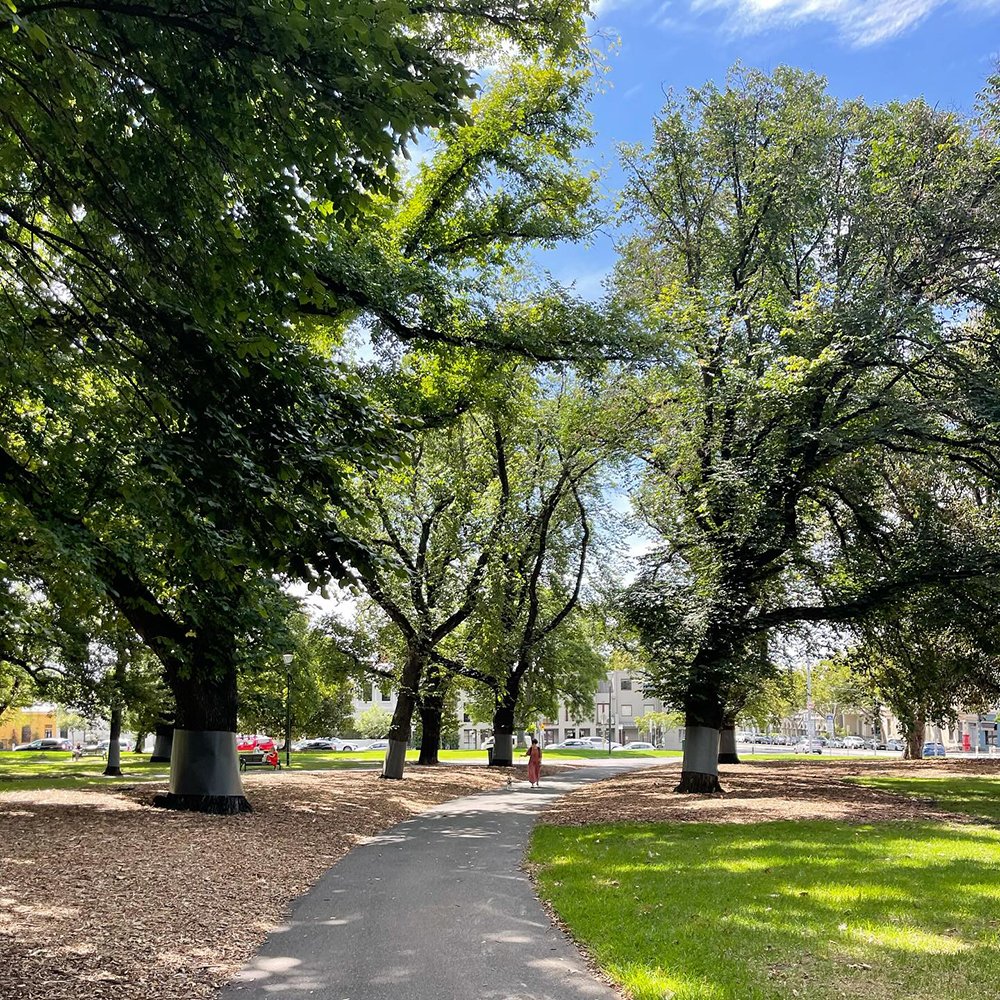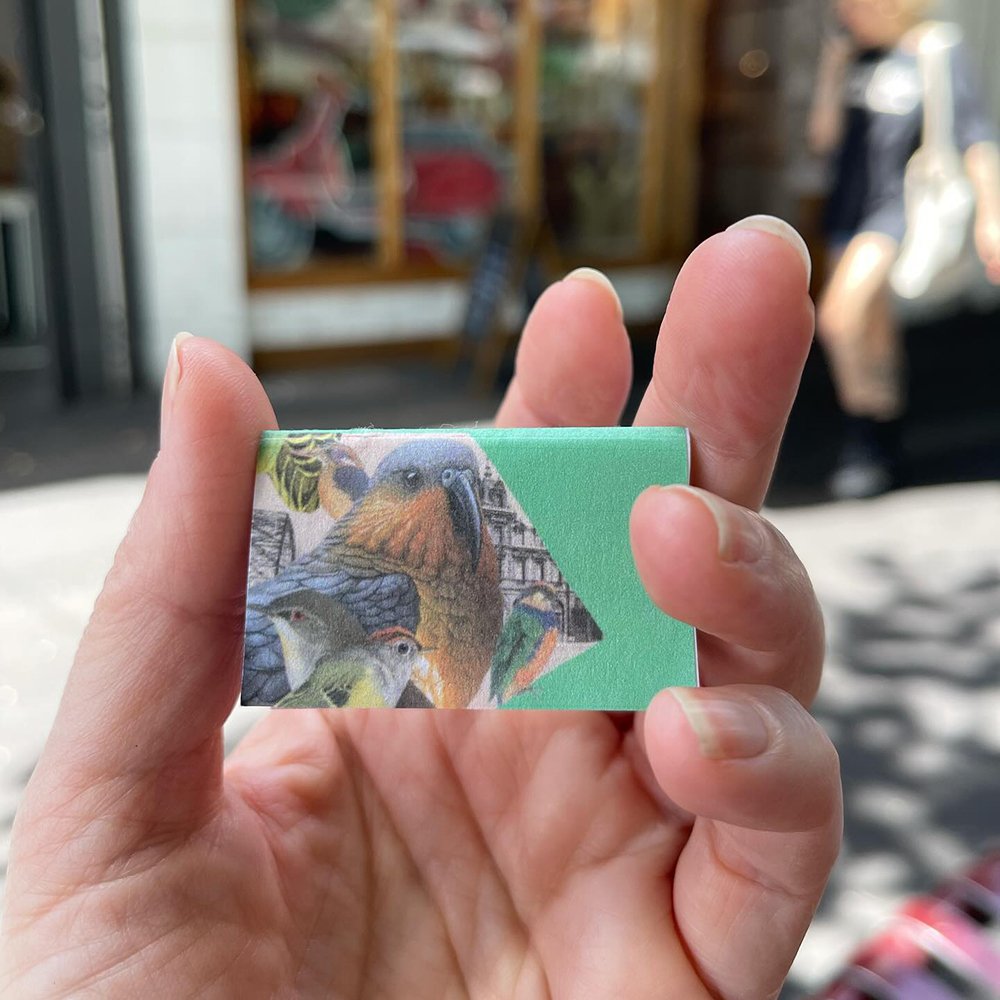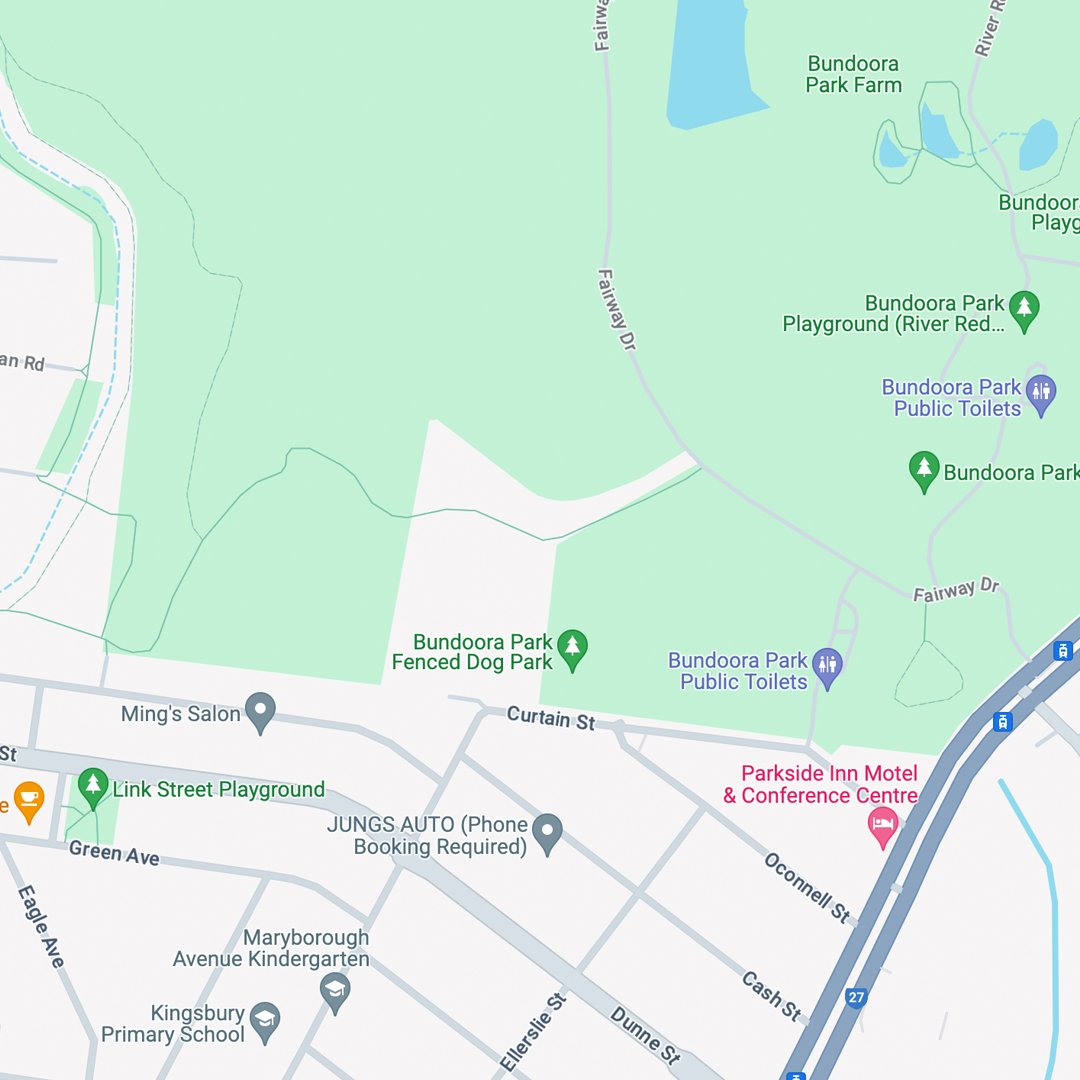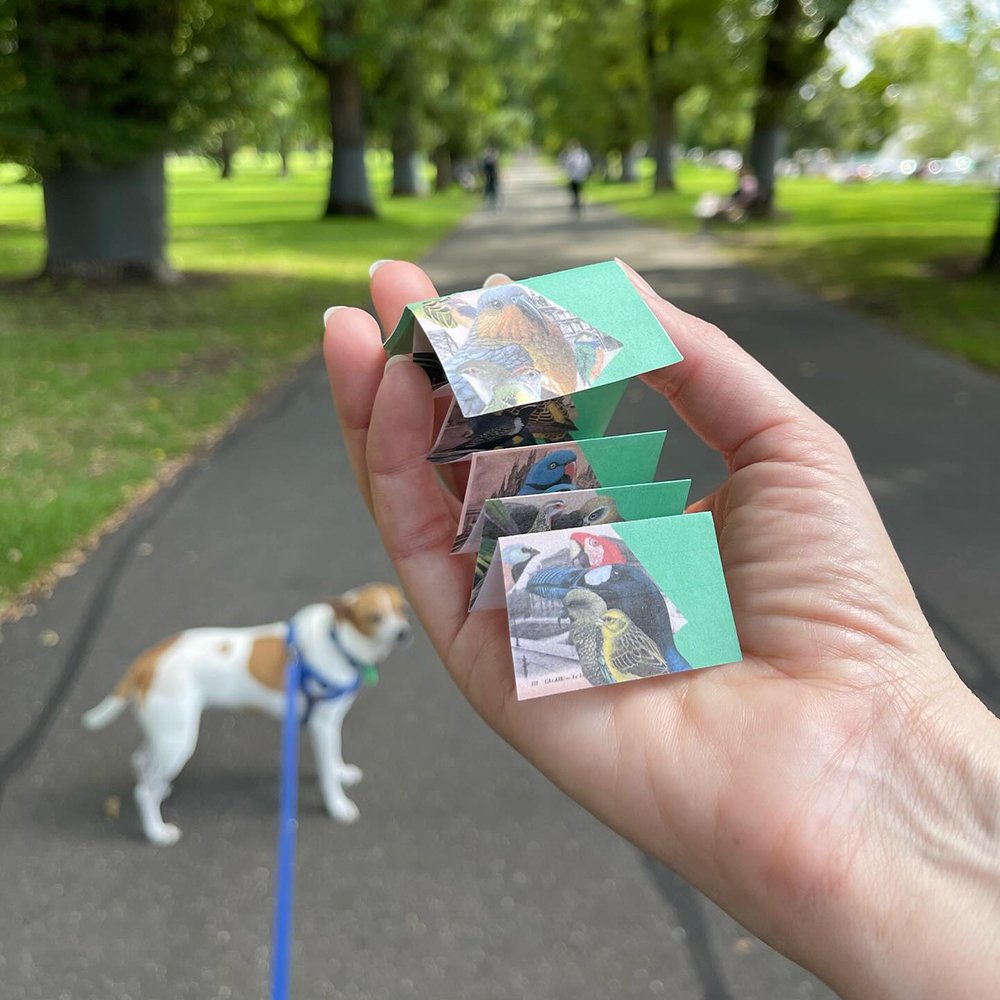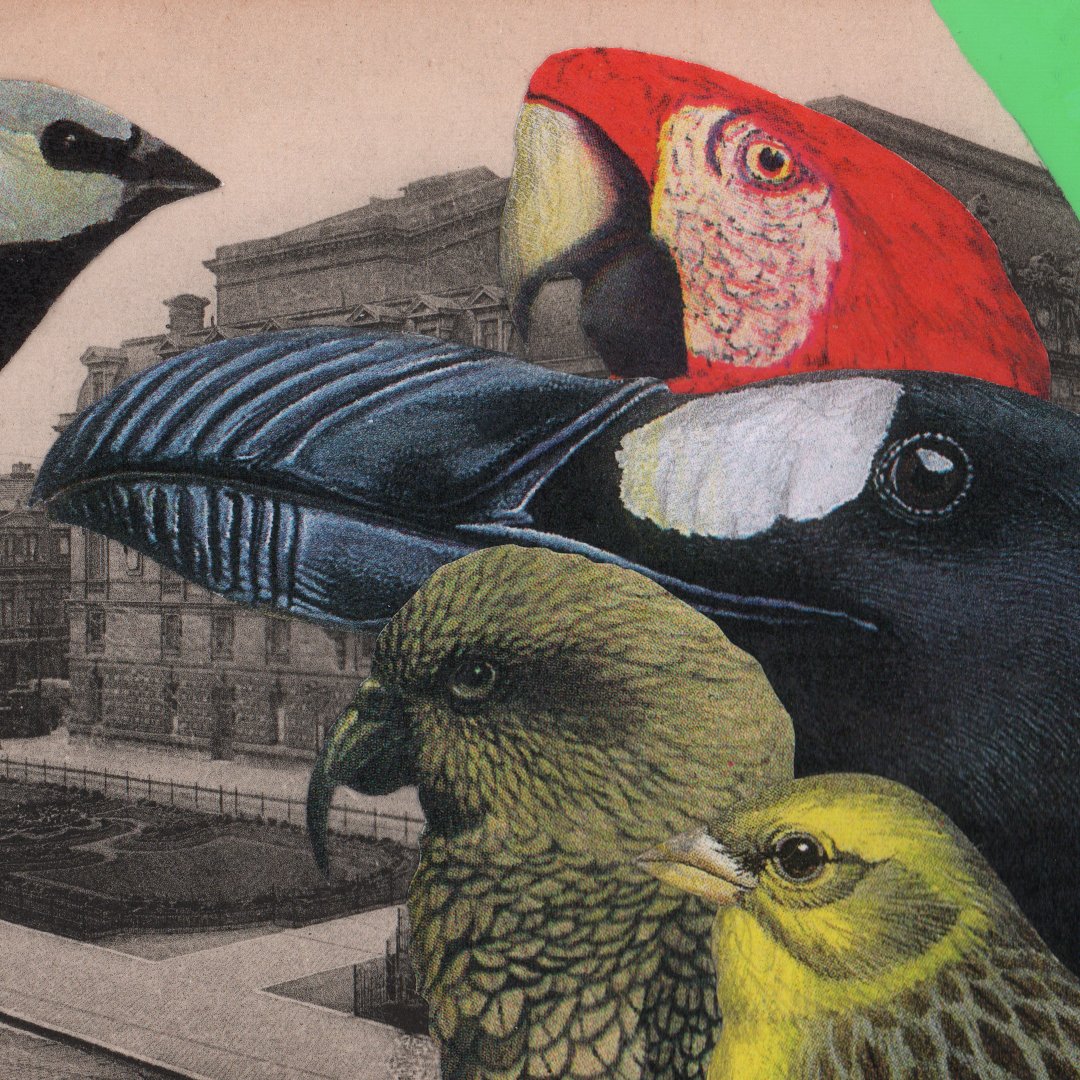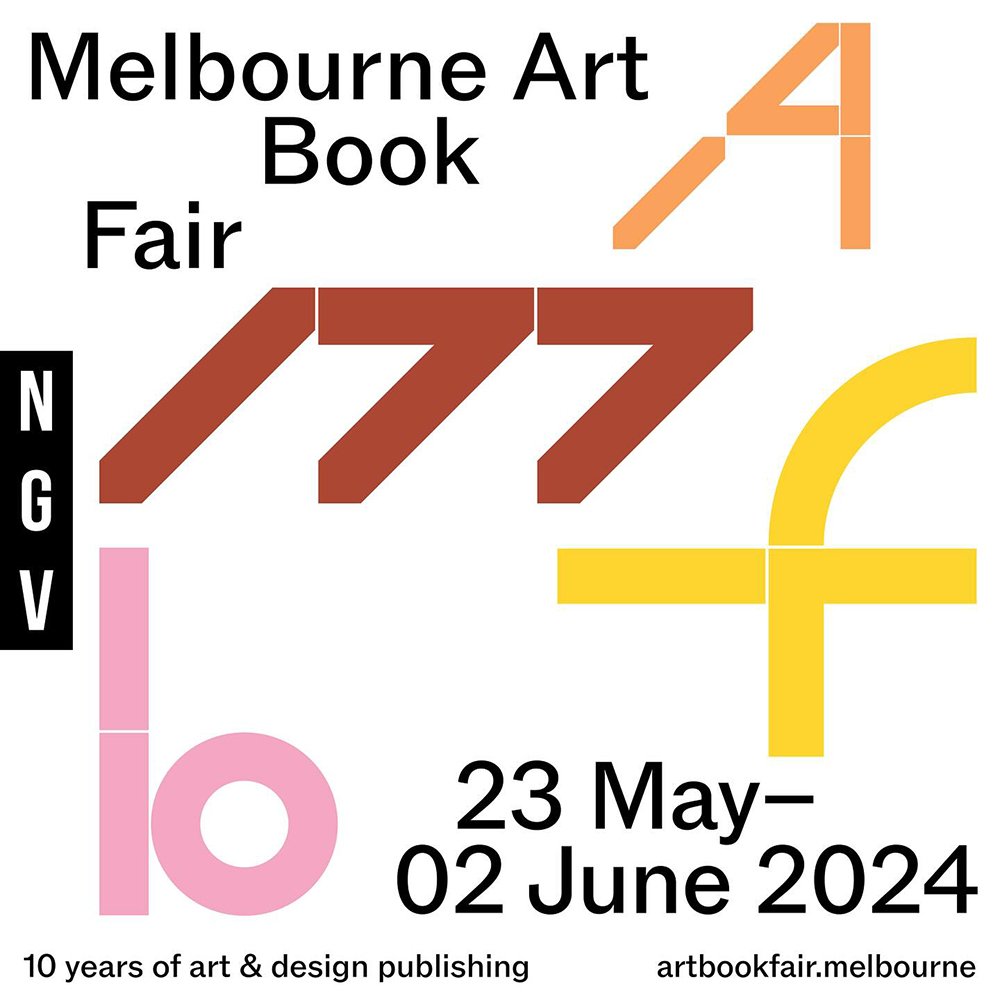LOOKING FOR GREEN, REMAINING HOPEFUL
And so we have a Golden bowerbird alongside an extinct Carolina parakeet, and postcard locations from Sydney, Australia to Milan, Italy.
Gracia Haby & Louise Jennison
Looking for green, remaining hopeful
2024
9 page concertina, artists’ book, Indigo Digital CMYK on 160gsm ecoStar + 100% Recycled Uncoated, with cover, Indigo Digital CMYK on 300gsm ecoStar + 100% Recycled Uncoated
Printed by Bambra
Bound by Louise Jennison
Edition of 75
We search the map for big green shapes to head towards. Sometimes these irregular shapes turn out to be less green upon arrival. Sometimes they are golf courses and cultivated lawns. Sometimes they get smaller, the closer we get.
In finding the reality of the mapped green shape to be ill-fitting, we cut the scenario anew and make a more befitting visual effect upon the green screen.
●
This series of ten analogue postcard collages, with a green area like that on a map, mirrors our own longing for green spaces to head towards, and a filmic green screen on which a potential environment more suited for a motley assortment of birds could sprout.
The materials used include old postcards collected specifically for collage, and a palette of birds cut out in readiness many years previous. The challenge we set: to use what we had to make something especially for World Book Night 2024’s theme, In praise of birds.
And so we have a Golden bowerbird alongside an extinct Carolina parakeet, and postcard locations from Sydney, Australia to Milan, Italy, all in celebration of birds. One of the original ten postcards, featuring said Carolina parakeet, was sent to organisers Sarah Bodman, Centre for Print Research (CFPR) and Linda Parr and exhibited at Bower Ashton Library, UWE Bristol, UK (Friday17th of April – Sunday 30th of June, 2024) and Learning Resources Centre, Hong Kong Design Institute (Sunday 1st of September – Thursday 31st of October, 2024). All ten feature in digital format in our artists’ book released at the tenth Melbourne Art Book Fair, NGV International (Thursday 23rd – Sunday 26th of May, 2024).
African pygmy kingfisher, Ispidina picta
Chestnut-crowned warbler, Seicercus castaneiceps
Norfolk kākā, Nestor productus, last recorded sighting: about 1851
Red-breasted pygmy parrot, Micropsitta bruijnii
Sri Lanka bush warbler, Bradypterus palliseri
Common reed bunting, Embeeriza schoeniclus
Crested shrike-tit, Falcunculus frontatus
Eastern black-headed batis, Batis minor
Scaly thrush, Zoothera dauma
Carolina parakeet, Conuropis carolinenis, last recorded sighting: February 1918
Common tern, Sterna hirundo
Fuscous honeyeater, Meliphaga fusca
Golden bowerbird, Prionodura newtoniana
Yellow-footed green pigeon, Treron phoenicoptera
American golden plover, Pluvialis dominica
Kaua’i ‘ō‘ō, Moho braccatus
Strong-billed honeyeater, Melithreptus validirostris
Yellow rosella, Platycerus elegans flaveolus
Little owl, Athene noctua
Northern hawk-owl, Surnia ulula
Savannah sparrow, Ammodramus sandwichensis
Southern boobook owl, Ninox novaeseelandiae
European roller, Coracias garrulus
Golden-crowned kinglet, Regulus satrapa
Newton’s parakeet, Psittacula exsul, last recorded sighting: 14th of August, 1875
Red-cheeked cordon-bleu, Uraeginthus bengalus
Bonon wood-pigeon, Columba versicolor, last recorded sighting: 15th of September, 1889
Golden bowerbird, Prionodura newtoniana
Northern lapwing, Vanellus vanellus
Peach-faced lovebird, Agapornis roseicollis
Common kestral, Falco tinnunculus
Red-necked spurfowl, Francolinus afer
Rusty pitohui, Pitohui ferrugineus
Southern boobook owl, Ninox novaeseelandiae
American bittern, Botaurus lentiginosus
Common grasshopper warbler, Locustella naevia
Great white egret, Andea alba
Mourning warbler, Geothlypis Philadelphia
White-vented euphonia, Euphonia minuta
Yellow-crowned parrot, Amazona ochrocephala
Atlantic canary, Serinus canaria
Black-throated finch, Poephila cincta cincta
Great auk, Pinguinus impennis, last recorded sighting: 3rd of June, 1844
Kea, Nestor notabilis
Scarlet macaw, Ara macao
﹏
RELATED LINKS,
RECALL, WORLD BOOK NIGHT 2023
RECALL
BIRD’S EYE VIEW: PERSPECTIVES ON ART AND THE SCIEND OF ORNITHOLOGY TALK AT MELBOURNE MUSEUM
RELATED POSTS,
AND SOMETIMES, IF WE LET IT
UNDERSTORY
BIRDS, WE’RE CURIOUS FANS
BOOK FAIR HIGH SPIRITS
GREEN SPACE FINDING
THERE BE BEETLES, AND THERE BE POSSUMS
TAKING FORM
A particularly noticeable feature of the dawn chorus is the behaviour of countersinging. Also known as antiphonal calling, it is the alternating of calls between two or more birds of the same species. Rather than singing over each other, neighbours take turns, and one hears them bouncing phrases back and forth. In this way, the silences they create are as important as their songs, allowing space to listen. As much as singing, birds at dawn are being sung to.
‘Avian Diplomacy — The Dawn Chorus’, from Deep Listening to Nature, Andrew Skeoch, Listening Earth, 2023
An exhibition hosted by Bower Ashton Library, Bristol, UK
World Book Night United Artists
ABBIE EDBROOKE, AGATA KORNY, AHLRICH VAN OHLEN, ALASTAIR NOBLE, ALI WOOZLEY, ALISA CHINNOCK, ALISON RAYBOULD, AMBER ROLLINSON, ANA PAULA BARROS, ANDREA HILL, ANDREA MOORE, ANDREA ROBINSON, ANDY GILROY, ANDY ROBSON, ANGELA CALLANAN, ANGELA CAPORASO, ANGELA JAMES, ANGELA THAMES, ANGELO RICCIARDI, ANGIE BUTLER, ANNA JUCHNOWICZ, ANNA WALSH, ANNE BOSSENBROEK, ANNE BUCKINGHAM, AOIFE RHATIGAN, BECK RICHINS, BERND W. PLAKE, BRIE BARNACLE, BROOKE KOVEN, CAREN DING, CAREN FLORANCE, CARINNA PARRAMAN, CAROL STARK, CAROLINE CASE, CATHERINE CARTWRIGHT, CATHERINE POLLEY, CATHEY WEBB, CATHRYN MILLER, CECILIA MANDRILE & MARIA DEL, CARMEN MARENGO, CELINE CHUN SZE LING , CHRISTINE DONG, CHRISTINE MARTIN, CHRYSTAL CHERNIWCHAN & CRAIG TATTERSALL, CLAIR SCHWARZ, CLAIRE B. MARCUS, CLAIRE FORWARD, CLAIRE SHIELDS, CLARE REVOLTA, CLARE ROGERS, CORINNE WELCH, DANIEL LEHAN, DAVID DELLAFIORA, DAVID NICOLATO, DIANNE GOACHER, DMITRY SAYENKO, ÉILIS KIRBY, ELAINE KNIGHT, EMILY LUCAS, EMMA BROWN, ERMÍNIA MARASCA SOCCOL, EVA HEJDSTRÖM, FIONA HAMILTON, FRANS BAAKE, GEN HARRISON, GERALD JATZEK, GERTRUDE, GRACIA HABY & LOUISE JENNISON, GRAEME MCNAY, GRUPO GRALHA AZUL LIVROS DE ARTISTA BRAZIL, GWEN SIMPSON, HANNAH GALVIN, HAZEL GRAINGER, HAZEL STRICKLAND, HELEN ROLLINSON, JACK BESSUGES, JANE S. BALCONI, JANE VIGUS, JANET ALLSEBROOK, JENNIFER WALLACE, JEREMY DIXON, JESSICA HO, JIL FAIRCLOUGH, JILL LAURISTON, JILL VIGUS, JO BARNFIELD, JO REED-TURNER, JON DUNNING, JOSEPHINE CORCORAN, JUDY RODRIGUES, JUSSARA LEITE KRONBAUER, KAR MERN TAN, KAREN CHRISTENSEN, KAREN DARLINGTON, KAREN F PIERCE, KATE BERNSTEIN, KATH BELL, KATHY BRUCE, KATRINA WHITEHEAD, KAUSAR NIGITA KAY RODRIQUES, KAYLEIGH DODD, KEI WING PHOEBE HUI, KIM SAUNDERS, KIT HARTLEY, KITTY OAKLEY, LIHIE TALMOR, LINDA FRANCE, LINDA PARR, LING PERRELET, LISA CLARE, LIZZIE BREWER, LORRAINE LAMOTHE, LORRAINE NEESON, LOTTE HUGGEL, LOTTI MÜLLER, LOUISE GRAY, LUCY GUENOT, LUCY WILLDER, LUIZA GUTIERREZ, MAGGIE BROWN, MAN YING LUO, MARA CARUSO, MARAMA WARREN, MARCIA ROSENBERGER, MARIA DO CARMO TONIOLO KUHN, MARIA WHITE, MARIAN KILPATRICK, MARIE-THERESE WISNIOWSKI, MARK VALENTINE, MARLENE MACCALLUM, MARTIN POLLEY, MARY RAREHARE, MAVINA BAKER, MEGAN HARRIS, MEGAN JENKINS, METTE-SOFIE D. AMBECK, MICHAEL HAMPTON, MICHELLE KEEGAN, MICHELLE LYNN DYRNESS, MIGNONNE BUSSER, MIKE CLEMENTS, MIKKO NG, MIREILLE RIBIÈRE, MÓNICA GOLDSTEIN, MORGAN CONNOLLY, NANCY CAMPBELL, NEIL CRAWFORD, NIAMH FAHY, MARIAN KILPATRICK, NORA QUINLAN, ODINE LANG, PAUL HEARN, PAUL SALT, PAULINE LAMONT-FISHER, PETER ANDREWS, PETER HEBDEN, PETER MCCALLION, PRERNA CHANDIRAMANI, QILING XU & DAVID WILKINSON, RACHAEL HOLLEY, RACHEL MARSH – SEMPLE PRESS, RACHEL SINGEL, RACHÈLE RIVIERE, RENATA DANICEK, RICHARD SHIPP, ROBERT CORRIGAN, ROELOF BAKKER, ROSEMARY EVERETT, ROSIE FORD, ROY WILLINGHAM, RUBY SAMS, SAM BRYAN, SAM JEWELL, SAM TREADAWAY, SAMANTHA HARTLEY, SANDRA LOPES, SARA BOWEN, SARA ELGEROT, SARAH BODMAN, SARAH FIGLIO, SHANIA SAMPSON, SHARMILA ARAVIND, SHARON HALL SHIPP, SHAUN OATEN, SHIH CHI LAI, SIGRID EHEMANN, SIRLEI CAETANO, SONIA LEGGETT, STEPHEN FOWLER, SU FAHY, SUCHADAR WHITE, SUE VALLANCE, SUELY CASTRO MELLO, SUMI PERERA, SUSAN BOVINGTON, SUSAN HOLMES, SUSAN SHAW, SUSANNE KLEIN, SYLEE GORE, T. J. ROBINSON, TAMAR MACLELLAN & PHILIPPA WOOD, TANIA LUZZATTO, TERESA OGANDO, THEREZINHA LIMA, TIM SHORE, TIMOTHY WINKLER, TSUI KIN WUN, VALERIE O’REGAN, VERA PRESOTTO, VERONIQUE POZZI PAINÉ, WENDY FALCONER, YASHFA RAZA, ZIE SMITH.
FRIDAY 19TH OF APRIL – TUESDAY 2ND OF JULY, 2024
BOWER ASHTON LIBRARY, UWE BRISTOL, CITY CAMPUS AT BOWER ASHTON, KENNEL LODGE ROAD, BRISTOL, UK
In Praise of Birds
For World Book Night 2024 — In Praise of Birds, WBN United Artists invited participation through reading and responding to a text or book about birds and sending us a postcard about it.
We will publish the collaborative bibliography on World Book Night as well as launching the video with selected images from the project, on Tuesday 23rd April 2024.
We are sharing the postcards in two exhibitions, a physical one here at Bower Ashton Library, UWE Bristol, UK, 19th April – 30th June 2024, and printout posters featuring all the postcards at the Learning Resources Centre, Hong Kong Design Institute (HKDI), 1st September – 31st October 2024. Alongside the main exhibition will be a display of postcards made by students at HKDI.
After the exhibition in Bristol, physical postcards will be swapped and sent out to participating artists with an extra gift from WBN2024 of commissioned postcards designed by rubber stamp king Stephen Fowler.
200+ artists responded to our call, with 250+ postcards winging their way to UWE from: Argentina, Australia, Austria, Brazil, Canada, France, Germany, Hong Kong, India, Ireland, Israel, Italy, Malaysia, the Netherlands, New Zealand, Norway, Pakistan, Poland, Portugal, Russia, South Africa, Sweden, Switzerland, Taiwan, Turkey, UK and USA.
Birds represented in the exhibition include: Asian Hornbill, Australian Magpie, Bar-Tailed Godwit, Barn Owl, Bearded Vulture, Bee-Eaters, Bewick’s Swans, Bittern, Blackbird, Blue-Black Grassquit, Bluebirds, Bluetit, Blue Dodo, Brambling, Buzzard, Canada Goose, Cardinalidae, Chaffinch, Chicken, Chiffchaff, Common Chiffchaff, Corbie, Cormorant, Crane, Crow, Cuckoo, Curlew, Dodo, Dove, Duck, Dunnock, Eagle, Eastern Yellow Robin, Egrets, Eider Hen, Elfin-Woods Warbler, Emus, Eurasian Collared Dove, European Robin, European Rollers, Eurasian Wren, Falcon, Flamingos, Friarbirds, Galapagos Finches, Goldcrest, Goldfinch, Goose, Goshawk, Great Black-Backed Gull, Great Tit, Grey Warbler, Hawk, Hermit Thrush, Heron, Hoopoes, House Martins, House Sparrow, Hummingbird, Kestrel, Kingfisher, Kookaburra, Lark, Little Bunting, Long Tailed Tit, Magpie, Mockingbird, Ñandues , Nightingale, Ornithes Areioi, Ortolan, Owls, Palestine Sunbird, Parrot, Peacock, Pelicans, Pewees, Phoenix, Pigeon, Pipits, Raven, Red Kite, Red-Throated Pipits, Robin, Rook, Rooster, Sanderling, Seagull, Snowy Owl, Songbirds, Sparrow Hawk, Starlings, Strigiformes, Stork, Sunbirds, Swallow, Swan, Swifts, Tawny Owl, Thrushes, Toucans, Tree Sparrow, Turtle Doves, Ugly Duckling, Vulture, Wagtails, Warbler, Wheatears, White Ibis, White-Tailed Eagle, Willow Warblers, Wren.
Q & A
Answered for RMIT University School of Art students, Rain Richardson, Sherin Prawira, and Alannah Borg
20th of August, 2024
Rain Richardson: What lead to your initial collaboration, and at the time did either of you imagine that you would still be in such a successful creative partnership over 20 years later?
Having organised a handful of group exhibitions together while at Art School, and having our studio spaces side by side, we knew that we worked well together, as well as enjoying each other’s company, so while we may not have fully foreseen that we would still be making work together, it is also in no way surprising. We have always shared a similar work ethic, but more than this, we have shared and grown a similar way of being in the world. A code of ethics, a set of principles, that type of thing. An openness, an honesty, in approach. A feeling that we are but a small part of a giant interconnected web. To the same end, we never set out to make our home, and by that, our home-based studio, a wildlife shelter, Tiny but Wild, but this, too, is no surprise.
In a way, Tiny but Wild, mirrors our collaboration and our approach. It is more a case of, well, why wouldn’t you? If you could, why would you not? If you could take in a quartet of ringtail joeys, and raise them until they are ready for soft release, why wouldn’t you? All of these opportunities that arise, they feed directly into our work, and they make us feel good. Our collaboration is definitely one of the ‘feel good’, rewarding ones. It is an adventure. And just as we never know what wildlife might come into our care and what they will present with, injury-wise, it is an unexpected, changeable, flexible, responsive, rewarding journey.
Rain Richardson: Has your work/life balance become more sustainable as your practice has grown?
It has remained as ever it was, however the things we do in the ‘life’ part have altered. There are considerably more Grey-headed flying foxes in the day. There is a greater sense of purpose or direction, in the sense that our artwork is to make a difference, to communicate. We use every opportunity to try to raise awareness for wildlife, in particular, but we try to do this in a subtle way. We want to encourage people. We want to open a doorway for them to choose to go through, if they wish. We want our work or our message to inspire hope, because hope is an action. And hope is something we all need.
Actually, if anything, the balance is more out of whack than is ideal, but the ‘work’ and the ‘life’ stuff have merged more, and the ‘work’ and ‘life ‘stuff give us purpose, joy, and set our brains, our beings, a-buzzing. Again, the answer, who’d have it any other way?
Rain Richardson: For those of us about to leave art school, what advice would you give us on maintaining and building our technical skills away from an institution? Do you have any specific advice for students such as myself who want to work in similar mediums as you? For example, bookbinding, creating zines, paper collage etc.
Connection with other people is so important. For so many varied reasons. Friendships for sharing the good and the hard times, and the average patches too. The opportunity to participate in workshops is also another way to stay connected to either people or skills or both, if this is a financial option. Seeing things, be it exhibitions or plays or film or dance. Grabbing cheaper ‘rush tix’ on the day and allowing yourself to be open to a new experience. An experience that feeds the head and the heart or both. The chance to look at something else and try to understand it. This way of looking at everything around you and trying to see. Trying to see from the perspective of another species. Trying to see what message there is in a film (we are currently immersed in the Melbourne International Film Festival and for the closing weekend we are particularly looking forward to seeing some early Iranian animation. The festival is our annual holiday. Our way to see the world without flying, and while still caring for wildlife. It is endlessly inspiring seeing how other people experience the world).
Zine fairs, like Sticky Institute, or local markets, too, are a great way to find a community and have something to work towards. To keep going is the key, and always adapting and growing; there is no need, and little interest to you, to make the same thing over and over. There are so many bookbinding ‘how-to’s on YouTube and similar which are a terrific resource if you are stuck. So many sites offer short courses, which can also be helpful.
Sticky Institute is a great place to have your zines, and their annual fair opens the world to a like-minded community of zine makers and people interested in zines. You can have a half stall with but one new zine and see where it unfolds. There are few gems like this. And tabling is free.
Whatever you do, do it with rigour, and attention to detail. Focus down onto one little thing. Be it a zine or something other. Because attention is vivid and political and active. It is forward-moving attention, not passive. Because there are many people with a vested interest in your acquiescence to look away. Or, to quote the brilliant poet Mary Oliver: “Attention is the beginning of devotion”.
Rain Richardson: What have been the most valuable relationships that you have made in your career? Both professionally and personally.
All of the printers we have worked with over the years have been amazing. We have always learnt a lot from their experience and enjoyed building a relationship with them over a long period of time, so that they know what we are aiming for in our work, and we know their skills and presses and what results or effects together we can achieve. It is another form of collaboration, really.
We’ve collaborated with people who make magnifying lenses, crafts people and technicians, other binders, vinyl installation experts, people from commercial printing backgrounds, fine art printers and framers, and many more; they have all taught us a great deal and been generous with their knowledge.
We see making like a theatrical or dance performance, where it takes many for the show to go on. Some of the relationships we have had with our supporters or collectors have also been invaluable. Their unwavering belief in us has helped us get through the darkest of times. Their validation has always helped us, fostering our never give up spirit. We have collectors of our zines, curators of institutions who have all supported us, sometimes for the entire length of our careers. We have learnt so much from them all. Some have taught us about artists’ books, some have taught us how to always laugh, some have whispered ‘just keep creating, never give up’ and given us an arm squeeze.
In addition to our art relationships, we have met many extraordinary environmental activists and wildlife carers who have taught us all our wildlife care skills and constantly teach us that we are always learning, and that the future isn’t written yet!
Rain Richardson: Do you have a favourite piece of art that you have made together?
It’s typically always the thing you are currently working on, isn’t it. Either that, or The remaking of things, our NGV commission as part of Melbourne Now because it was so huge a room to fill and so incredible a stage for us to unfurl our collage forest. That it grew to include the education component was a wonderful gift. A way to really ensure that our message could be made, a case presented, a bid to say; would you not look at the natural world we are a part of in every sense. Would you not take action to ensure what is left remains, and that corridors are strengthened, that all species can flourish. In the places where established trees remain, outside of parks and reserves, wildlife clings on. To the trees by the side of the road or the train tracks. The scrubby patches, the fringes we humans have left. And in this patch, they can still ingeniously prosper. Imagine what it could be like if such areas were extended a little further and cleaned up a little more (cleaned up in the sense of litter, and more native plants/food trees).
Each work we have made has presented a unique set of parameters, and these, plus the people we met on the way, and the people we in turn share the finished work, make each work a favourite, really. Working on Ripples in the Open, we were able to flex our muscles in new ways, adding a sound collage. But it needn’t be the biggest project nor the most different.
Rain Richardson: If you could save one endangered animal species right now, which would it be?
So hard to choose but one. The numbat, the Eastern quoll, the woylie, the Gouldian finch, the Purple-crowned fairy-wren. There are so many, how could we pick but one? Can we pick a large tract of land instead that supports an abundance of life?
Our aim is often through beauty, humour, and the poetic, to make people love all the animals and the plants within.
What species would you pick?
Sherin Prawira: What is your thought process when creating a collage? If I have to create such complex and intricate collages, I feel like it would take me hours or even days to find the right images for them. Do you sometimes feel overwhelmed? Or have years of experience and research allow you to find the right source material quickly and efficiently?
We always start with collecting a palette for each project. We may use pieces from other palettes, but each project, be it a wall collage or an artists’ book, has its own unique pool of images. It helps us to not repeat ourselves, and to remain focused. It means unexpected patterns emerge, though perhaps they are not unexpected, and it is more a case of you stepping back and seeing that all the images are of a similar hue or have similar shapes throughout them.
We begin by knowing what we want the work to be, very specifically. But then, in the harvesting of images, we let this go, let it take a back seat, and we see what we are drawn to. In the beginning, we know exactly what we want the piece to look like, but in the making, it is not always possible to find everything. So, your idea changes form around the edges because it is based upon what you find (file size needs to be high, even with the option of using Gigapixel, for example).
The collage, digital or analogue, is blocked in very quickly, as if an orchestrated dance. It is done with complete focus and with a looseness, in the sense of wanting pieces to come together harmoniously and for your eye to glide from one form to the next. Once you have everything in place, then you can set to neatly cutting them out, and gluing them in place. It is very slow, but enjoyable. And you can see it all come together, bit by bit. Sometimes we weave in new pieces, like finishing touches, but the base of the composition remains the same.
We spend a lot of time in journal archives because there is such a wealth of knowledge out there. In all of our projects, there is always much more research and many more collected images than what goes in. Some pieces collected in our palette are too complete and don’t leave us enough room.
In all things, it becomes more a decision of what to leave out than what goes in. Each work, we hope, is something both big and compact.
Sherin Prawira: As a part of my assignment, I’m told to do a small project based on each source of inspiration I found. I would like to try creating nature-themed collages after seeing your works. Do you have any tips and tricks for a complete beginner like me?
To convey a sense of nature on the page, we think about how we feel when we are looking up at the sky or walking through the forest. What does it look like when you are walking, and what does it look like when you stand still? Can you hear more? Can you hear the pardalotes in the medium canopy, flitting about? How does the light flicker through the leaves? Is the forest dense? Varied? Why are we there and why are we recreating it on the page?
Our artists’ books, like Restoring corridors, or our large-scale installations, like The remaking of things, are a bid to say: would you look at what there is around us; what surrounds us. Would you look at the destruction of what we humans have done; would you look at the litany of the mistakes we have made and what that might tell us about ourselves.
We are in awe of nature, but we are mindful that humans in our hunger for the living world, we have both cherished and destroyed it. So, we make work to celebrate nature and highlight what we can do to help preserve what is there, because every injustice, diminishes us all, and every loss is all of our loss.
On a technical level, when cutting out, say, a many-boughed tree, there are shortcuts to take (hello Magic Wand in Photoshop), but these tend to look like shortcuts (unless the ragged edge is a part of your intended aesthetic and it yields results that convey your message). Our work process is slow, and we are zoomed in on the details so that the viewer or reader, when they press their nose up to it, cannot fathom, we hope, how it has been woven.
In short, we wouldn’t have it any other way.
Alannah Borg: How important are your socials in building connections within the art world? Do you think having an Instagram, LinkedIn or website is just as if not more important than physically including yourself in spaces where you meet people within the industry?
For us, our Instagram and our site, with our blogs, Elsewhere and High Up in the Trees, in the early days, and Marginalia, now, have been invaluable. Invaluable to us, personally, for we can make many small projects just for the fun of it, and feature these on Instagram. And this act of play and notion of sharing can sometimes yield something unexpected.
It has been how we’ve always connected with other like-minded people, and it keeps us focussed and engaged. The digital space can be our own gallery. Our own entertainment, when used as a diary to document something we’ve seen or are thinking about. And as a means to share what we have made, because we want to communicate with other people. We want other people to think about how Grey-headed flying foxes pollinate our forests as we slumber. How frogs from one area can or can’t navigate to another, depending upon green corridors. We hope our work gives a sense that it is still worth it. A sense that, yes, there’s chaos, but larger than the world’s chaos are its miracles, and artists’ books or work that offer you a blueprint for what joy looks like, what a future looks like, what being reciprocal with nature means, this is what we are interested in. This applies also to social media for it ripples further than we could ever hope. And we apply the same attention to detail to it, in many ways.
It is also an area we are comfortable in. Sculpting words and playing with different technology. We enjoy creating reels that allow you to be up close nose to nose with a Grey-headed flying fox or a ringtail joey (while still remaining at a distance so that wildlife in care remain their glorious wild selves). We are interwoven, in so many ways.
Our site, too, is a great way to archive all the different strands and self-promote, for want of a better expression.
Meeting people in person, at, say, the NGV Melbourne Art Book Fair or the annual Sticky Institute Zine Fair, is a highlight, a thrill. And it often leads to other opportunities. It can feel more tangible, though this might not be the case. For the main, it strengthens ties already formed electronically.
Alannah Borg: How did you push for your work to be recognised? Was this through contacting galleries, selling your work at markets or were you discovered through your socials? Was meeting people within the industry helpful in getting your work out there?
For the main, we’ve just kept making, kept inventing projects, and making things bigger and bigger, in the sense of extending an exhibition by making an accompanying zine, by researching a project deeply and writing something to accompany a body of prints on the gallery wall. By throwing ourselves in deeply. And it is to this end, turning every opportunity, no matter how small into something bigger that we have challenged ourselves, and enjoyed the challenge, and found the drive to keep going, even when things are lean. The feedback we receive about our socials has, so far, been heartfelt and encouraging. This inspires us. And it encourages us to post authentically, and about things which are of particular interest to us. There are many ways to drive bigger numbers to your profile, but we have not followed such things as they’ve felt both hollow and unsustainable. We are interested in staying true to what we are truly interested in.
Alannah Borg: When starting out, how did you handle rejection? Have you ever been turned away or have received negative comments about your work? How have you then pushed forward without it affecting you?
Sometimes we’ve been able to turn an unsuccessful application or proposal into a new and different work, because we like the idea and it could translate to, say, a zine. Sometimes we’ve gone ahead and made the artists’ book or project anyway, because we still believed in the project even if it didn’t receive the funding or whatever outcome it was. And sometimes we have made a work in spite of negative comments, in particular an early series of unique state artists’ books that were seen as vandalism; it can be a fun form of rebellion to follow through with it anyway.
In terms of rejection, it often helps us to think of the famous letter, which includes the brilliant, “First, we must ask, does it have to be a whale?”, sent to Herman Melville. “We have read with great interest your intriguing effort of Moby Dick, or The Whale, and while it fortified us greatly, despite the somewhat vision-impairing length of the manuscript, we were wondering if changing certain of the story’s elements might not buoy its purchases at the shop, as it were?”
Alannah Borg: How do you navigate pricing your own work? How do you figure out how to price, knowing either a gallery/business will take commission?
We are independent, so we try to avoid gallery commissions where possible. And we have always tried to keep things at an affordable price, and at a range of prices. Part of the reason we love making zines is because near everyone can afford to purchase a $4 zine about a Honey possum. Many of our artists’ books have included a pocket-sized zine version. This component, this egalitarianism is important to us.
Alannah Borg: Because paper isn’t the most sustainable materiality, how do you go about trying to make more conscious choices with your practice? What processes have you found help in the recycling of paper and other materials?
We all have a list of things we can do on a personal level to make the world a better place and ensure we remain hopeful: consume less, lobby your politicians, eat less meat, but this is a list of things we already know. So, our artwork is our way of saying, here’s what we can do. The subtext being, though we are not endangered yet, we are endangering ourselves as we endanger everything.
This was something we had to weigh up with our collage The remaking of things, which, at the end of the day, was unrolled from the wall and popped, we imagine, in a skip. We had to consider if the outcome warranted the expense. We had to consider was there another way to make the work, and if not, make sure that the work, and the message behind the work, was important and worth it. The collage activity at the middle of the room invited people to make their own habitat for the Grey-headed flying fox and all who fall beneath their care. It was important to us that this ‘activity’ was not just a way of saying ‘isn’t nature, in its place, pretty’ and continue the tradition of taking, taking, taking. It needed to carry the message that these marvellous creatures are our pollinators, are our forests, our vital.
As the author Katherine Rundell comments, the greatest lie we ever told is that the world is ours and at our disposal, and it is a lie so huge and so deep and so lasting that it has the power to kill us all. Our work attempts to work against that lie, and to offer the idea that your politically informed, active, iron-willed cherishing of that which exists is what is needed now, and that sometimes that cherishing, it needs to have love in it.
But there are things we can do to lighten our footfall further. Recent works on paper we have had framed have been made from recycled timbers and pine which have been stained to look like hardwood. There are many ways we can all make our practice greener or kinder. It is up to each of us to find ways we can do so and ways we can afford, because the most sustainable methods in the studio are not always within our budget. We have invested in solar, and disconnected from gas, to reduce our footprint. But this is something we’ve only recently been able to realise, financially. It feels pretty momentous!
Part of our work as wildlife carers is a way to readdress the balance, but this too involves a lot of water (washing enclosures, and bat wraps) and fuel (driving to rescues and soft release sites). It is hard to weigh up, but ultimately, we feel that we are making a positive difference.
Thanks for asking us these interesting questions, and we hope these answers prove helpful, Rain, Sherin, and Alannah.
Cheers,
Gracia & Louise
QUESTIONS POSED (Marginalia)





